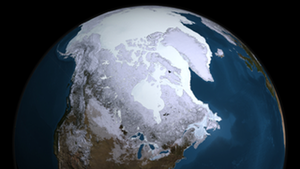Simulations Strengthen Earth’s Magnetic-Field/Climate Connection
Rock samples show that variations in Earth’s magnetic field over tens to hundreds of thousands of years are roughly synchronized with the ice ages. In Physical Review Letters, researchers present a simulation that strengthens the case that the field was influenced by climate changes. The simulation shows that the magnetic field is stronger when Earth rotates faster, which could have occurred when the polar ice caps expanded. The researchers’ model assumes an unrealistically large variation in Earth’s rotation rate in order to show the effect clearly, but the findings could still help geophysicists better understand the value of Earth’s magnetic field record as an indicator of climate history.
Earth’s magnetic field is produced by heat-driven fluid motion in the layer of molten metal below the mantle. As the liquid moves outward from hotter regions, the Earth’s rotation forces the flow to curve into a complicated pattern. Electrons in this flow generate a current that creates a field similar to that of an electromagnet made from a coil of wire.
This field shields life against harmful cosmic rays, so geophysicists want to know if climate changes—either natural or man-made—can alter its strength or direction. Ocean floor sediment shows that over the past two million years, changes in the Earth’s field have been roughly coincident with ice ages, but it’s not clear if climate changes were the direct cause of changes in the field.
One possibility, however, involves the extra water mass that accumulates near the poles as ice during an ice age. This increased polar mass lowers the planet’s rotational inertia and, like a spinning ice skater pulling her arms inward, causes the Earth to spin faster, which generates a stronger field from the electrons in the core. But the strength of this effect and its details have been unknown, in part because computer simulations over such long geological time scales are so difficult.
Takehiro Miyagoshi and Yozo Hamano of the Japan Agency for Marine-Earth Science and Technology in Yokohama have now simplified the problem enough to perform a long-term simulation of the effect of rotation rate on Earth’s magnetic field. They used an existing model of the molten outer core as an electrically conducting fluid between a hot, rotating inner core and a colder, rotating, outer spherical boundary that represents the bottom of the mantle. The simulation accounted for fluid motion, heat flow, and electric and magnetic fields, and it took about 100 hours to run on a supercomputer over a period of two months.
To reduce the complexity of fluid motion, the team used a common trick: they assumed a very high fluid viscosity and a very low rotation rate. The ratio of these two numbers, called the Ekman number, was about 10 billion times higher than it is in reality, though only ten times higher than the typical assumption in such simulations. High-Ekman-number simulations are essential to reduce the computational requirements and for now represent the best that researchers can do to model the Earth’s magnetic field.
Miyagoshi and Hamano began by simulating 200,000 years of steady rotation, after which they introduced a 2% oscillation in Earth’s rotation rate, equivalent to shortening the day by a maximum of about a half hour. This is much greater than the expected effect of an ice age, which would be about a second per day, but since their virtual Earth rotated a thousand times too slow, they needed to exaggerate the oscillation in order to see some effect. To their surprise, the magnetic field strength oscillated with roughly the same shape as the rotation rate variation (a sine wave) but with a much larger amplitude of 25%. The team says that with the Earth’s faster rotation speed, even a much smaller, more realistic oscillation in rotation rate may have a noticeable effect.
Mathieu Dumberry of the University of Alberta in Canada says that repeating the simulation with more Earth-like parameters is an essential next step, to see if the large field variation holds up. “If there is a connection [between climate and field], then we can use the field record to aid us to understand past climate variations,” he says. “If we can understand variations in the past, we’re better equipped to understand climate variations in the future.”
–Jessica Thomas
Jessica Thomas is the Editor of Physics.
More Information
How the Earth generates a magnetic field (the geodynamo) (University of California, Santa Cruz)
How the Earth keeps its field going (Pennsylvania State University)
Oscillations in the Earth’s tilt and orbital path that lead to climate oscillations (the Milankovitch cycle) (About.com)





